Pop-up books enthral readers for many reasons: their ingenuity, their beauty, and because they challenge the two dimensional nature of printed books. For more than 700 years artists, philosophers, scientists and designers have employed a range of paper engineering mechanisms to include moving parts in books. This early history of pop-up books illustrates developments in paper engineering.
Until the second half of the eighteenth century books that included moving parts were primarily scholarly publications. Volvelles were used in astronomy in the 15th century to represent the movement of the planets. Shown below is a wheel chart held by the National Library of Scotland, developed in 1540 by Petrus Apianus (1495- 1552). Astronomicum caesareum employs images of red dragons on wheels that rotate separately, and are designed to chart the orbital period of the moon.

Astronomicum caesareum, 1540, from the National Library of Scotland’s blog post
The earliest example of a movable book is older still. A Catalan mystic, Ramon Llull (1232-1316), in the thirteenth century used revolving discs or volvelles to illustrate his theories and predict the future. His was a system of paper wheels fastened to another leaf so that the discs spin independently. Llull used this technique to answer questions about creation, the future and to settle religious debates.
Andreas Vesalius (1514- 1564) during the sixteenth century, used paper engineering to teach human anatomy. He printed layers of human entrails fastened at one point at the neck and, as the flaps were lifted, layer after layer of anatomy was uncovered. Similarly, contemporary paper engineers David Pelham and Jonathan Miller employed sophisticated methods in their 1983 three dimensional study The human body .
In the eighteenth century paper engineering began to be used in fictional works. London publisher Robert Sayer produced the adventures of a character called Harlequin in 1765 in a series that became knows as the Harlequinades. In these books, flaps would open up and down to show the progressive narrative of Harlequin’s adventures.
In 2005 Norman Messenger created a picture book called Imagine where readers can view transforming fantasy creatures by similarly lifting flaps and becoming immersed in the magic.
But it was the nineteenth century that saw a marked growth in movable books addressing a child readership. London publisher S. & J. Fuller created a Paper Doll book in 1810 called The history of Little Fanny . Its revolutionary format, for its time, was created with each page displaying an illustrated costume that could have a cut out face inserted into it, to complete each look.
Any child lucky enough to own a copy of the book could then dream up their own story-lines for Little Fanny, and in a later publication her male equivalent Little Henry.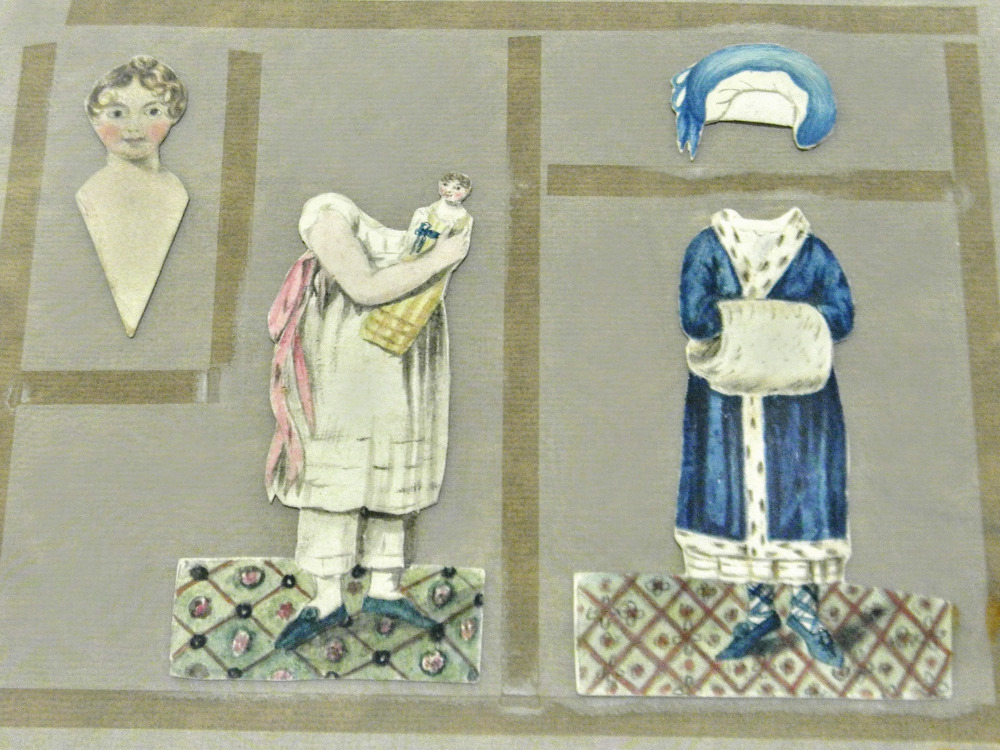

Little Fanny from the Osborne Collection
In the 1820s William (1751- 1830) and Stacy (1790- 1863) Grimaldi first published what was known as Toilet Books featuring items that appeared on his daughter Louisa’s dressing table. William is reported to have made nine drawings, folding each in half, for entertainment at a family party. His son Stacy saw a publishing opportunity and released them in 1821 as The toilet. Another release titled A suit of armour followed in 1824 with eleven drawings of pieces of armour. Shown below is the image for Rouge. When the flap is lifted, inside the virtue of modesty is revealed, described in the Booktryst blog
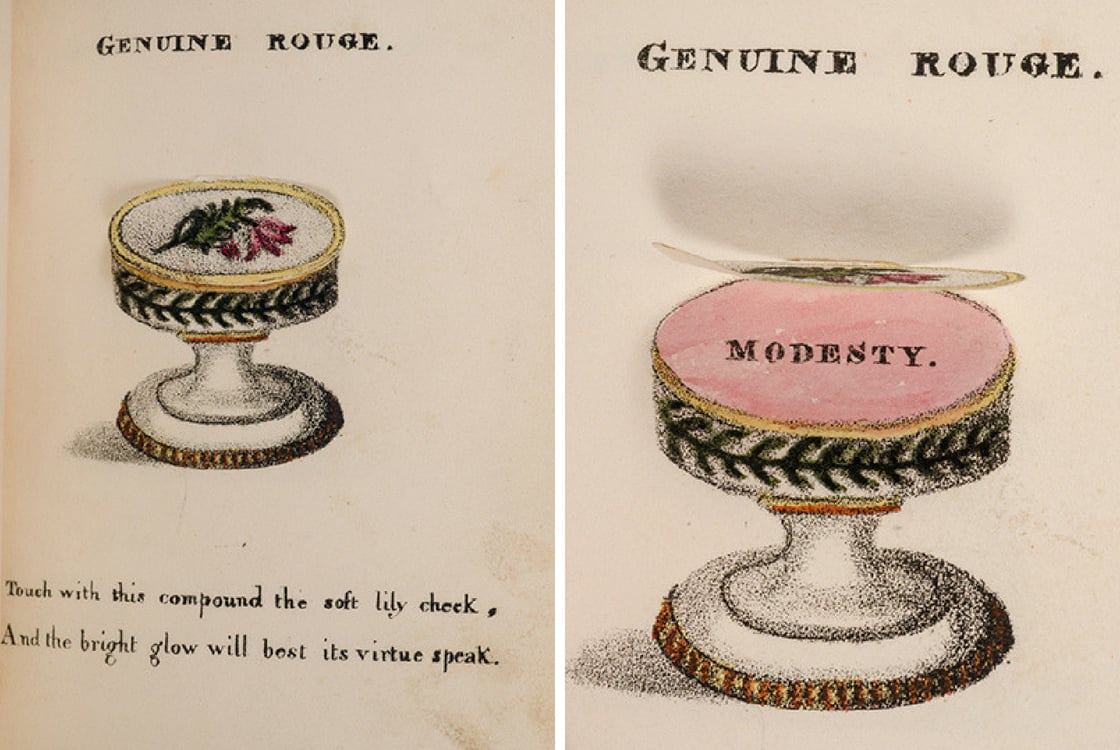
The toilet with flap down [L] and lifted [R], from the Booktryst blog
In the mid nineteenth century the publisher Dean and Sons established a special department of skilled craftsmen who prepared handmade mechanicals for movable books. In addition to Dean’s Peep Show books, they developed books with transformational plates based on the venetian blind principle. This Booktryst blog describes some of Dean and Sons moveable books.

Dean and Sons Peep Show from the Booktryst blog
Ernest Nister (1841- 1906), born in Germany, based his publishing house which specialised in movable books in Nuremberg. It was a toy making centre at the time, and later he opened an office in London. Nister’s pop-ups stood up as the pages turned by a system of connecting tabs between the first page of a double page spread and the cut out illustrated page. Prior to his innovative work, pop-ups were manually maneuvered into new configurations.

Peeps into fairyland, 1896, title page

Peeps into fairyland, 1896, illustration of The fairies’ lake

Peeps into fairyland, 1896, The babes asleep in the wood

Peeps into fairyland, 1896, illustration for Fairy Fircones
The most ground-breaking movable picture books of the nineteenth century were devised by Lothar Meggendorfer (1847-1925). He worked in Munich and brought his unique humour in combination with ingenious mechanical devices to children’s picture books. Meggendorfer included multiple movements on a page. Sometimes there were five parts of the illustration moving simultaneously in different directions. He sometimes used tightly coiled copper wire to attach levers so that a single tab when pulled would activate all of them with some mechanisms delayed until the tabs were pulled further out.
In 2013/4 the National Library of Scotland featured Meggendorfer’s International circus in their Treasures exhibition ‘Pop up!’.
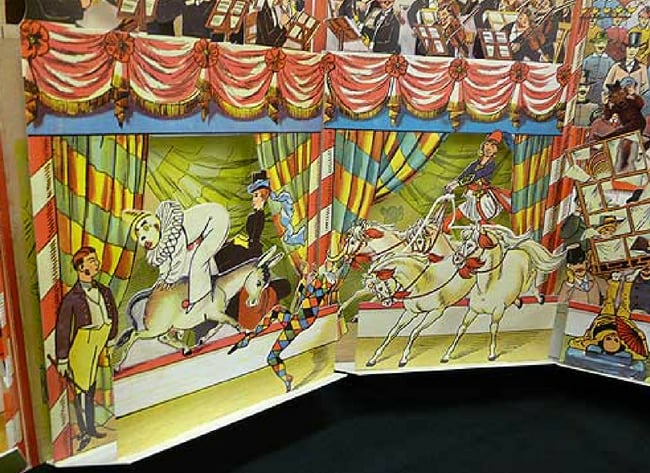
Lothar Meggendorfer’s International circus, from the National Library of Scotland treasures blog
At the turn of the twentieth century Frederick Warne & co. produced a short print run of two stories by Beatrix Potter in concertina format. One was called The story of Miss Moppet. When issued, booksellers became reluctant to stock copies because they became easily unrolled and were troublesome to fold up again.
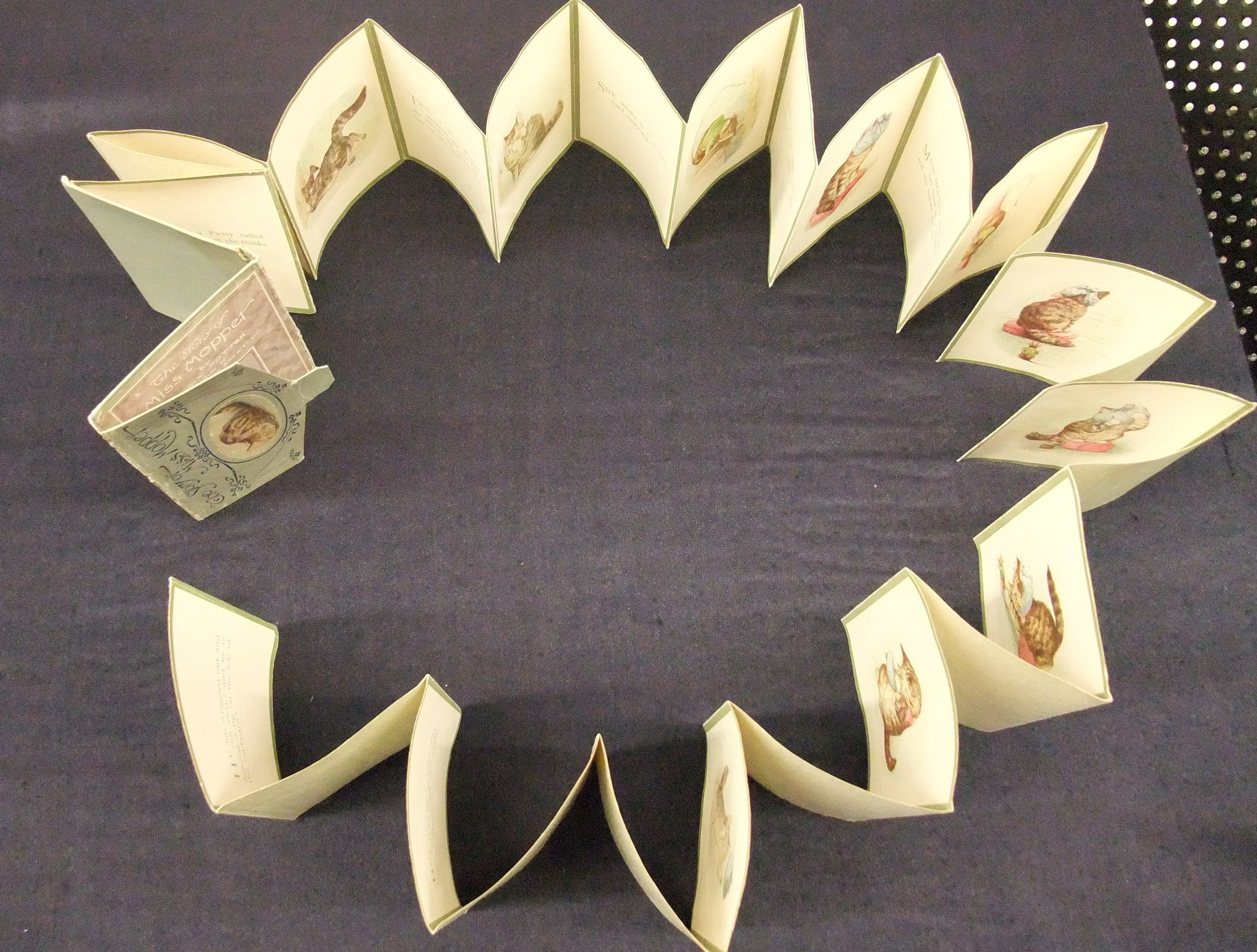
The concertina format of The story of Miss Moppet, 1906, folded into a cloth bound purse
Developments in paper engineering showcasing nineteenth century works by Ernest Nister and Raphael Tuck to contemporary creations by Robert Sabuda, David Carter, Sam Ita and David Pelham will be shown during Juliet O’Conor’s collection presentation for 2018 Rare Book Week.
References
- Online concise history of pop-up and moveable books
- Movable Book Society a nonprofit organization, provides a forum for artists, book sellers, book producers, collectors, curators, and others to share enthusiasm and exchange information about pop-up and moveable books.
- Pop-up and movable books: a bibliography, by Ann R. Montanaro, 1993.
You may also like
Illustrated children’s books: Randolph Caldecott (1846-1886)

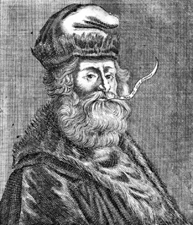
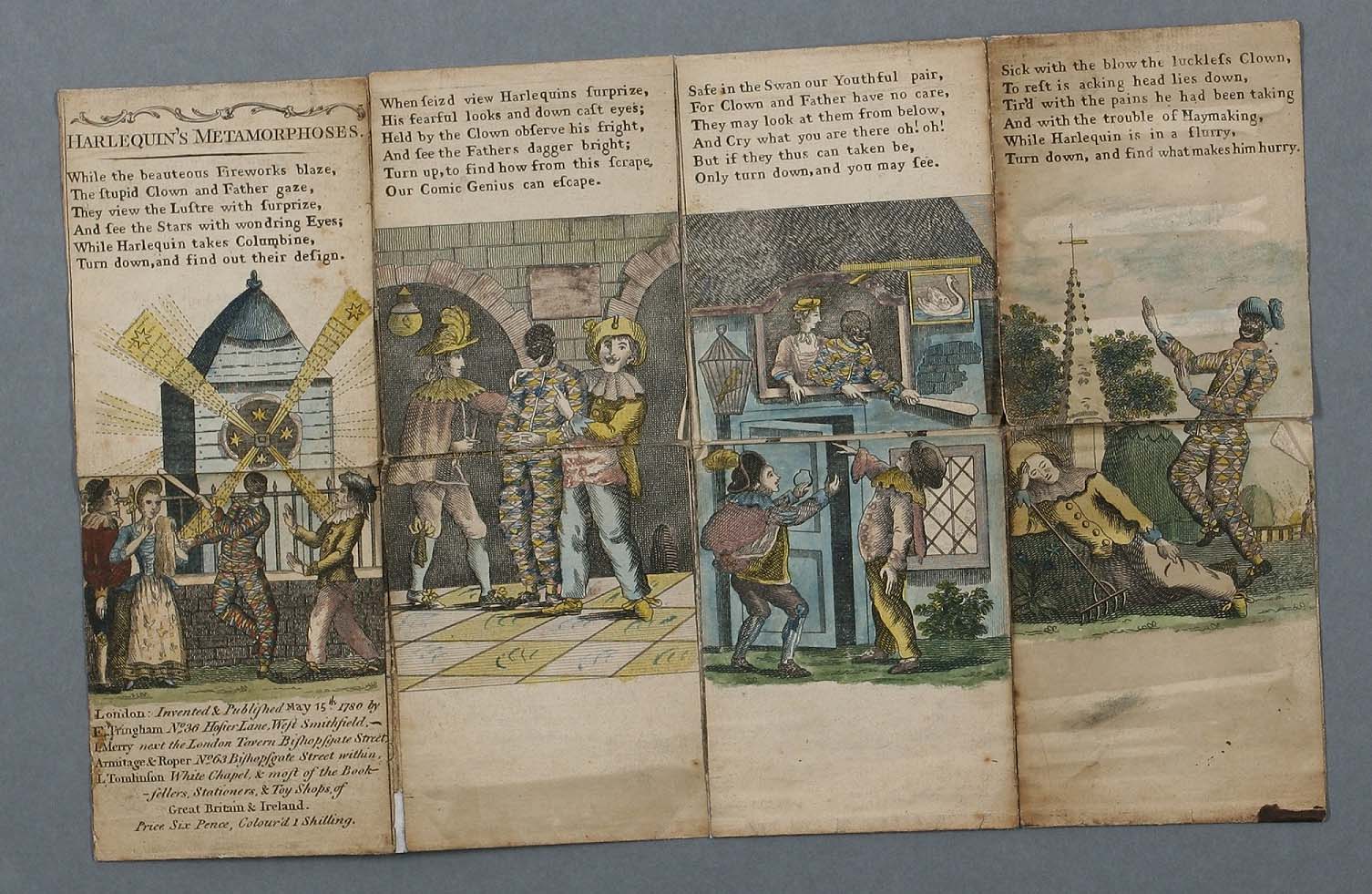
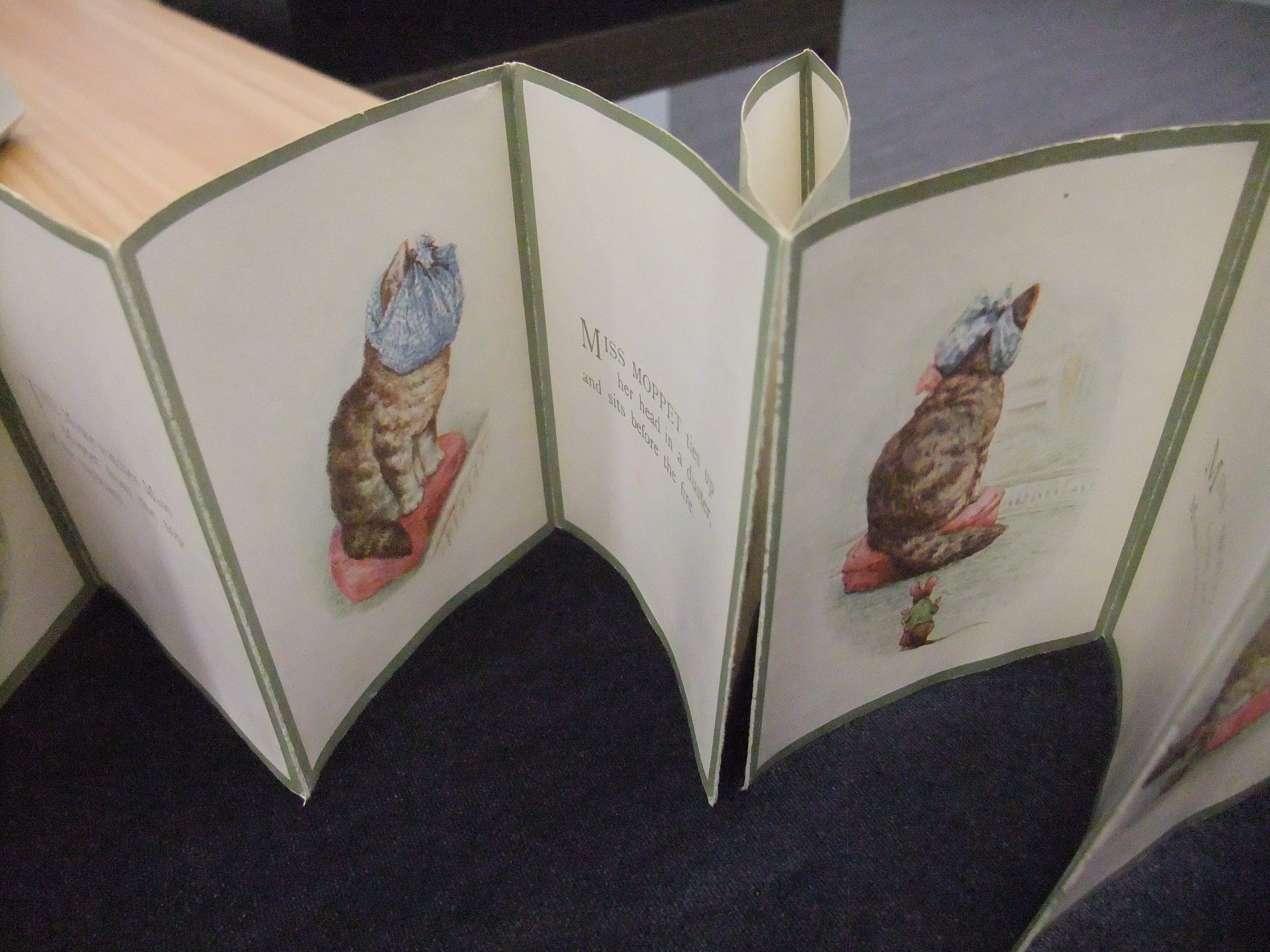

This is wonderful, Juliet. Once again I am inspired by your knowledge and experience.
Hi Judy,
Thank you so much for your comment. I’m glad you enjoy the additional information I was able to bring to my collection based presentations for Rare Book Week, some of which I included in this blog. Many thanks, Juliet
Around 1955, my family bought a copy of a remarkable 3-D pop-up peepshow book by Kathleen Hale, author-illustrator of books about Orlando the Marmalade Cat.
Wikipedia: http://en.wikipedia.org/wiki/Orlando_(The_Marmalade_Cat)
This was “Orlando’s Country Peepshow”.
In fact this was less a book, and more a visual experience.
It was designed to be fully opened, by pulling back the front cover to abut the back cover, revealing FOUR 3D theatre-like scenes, one for each season of the year.
The effect is of four rooms, opening like sections of a carousel or merry-go-round.
In Hale’s world of Orlando, he is a farmer, and each season shows what is happening on his farm at that time of year.
On a different topic, but Australian children’s books, it might be interesting to explore the titles of the Australian series, a counterparts to “Little Golden Books”, titles from the “Little Wonder Book” series, including The Calf Who Couldn’t Moo, The Mouse Who Was Boastful, Peter Cat, Tommy and His Pony (perfect for someone with a friend who was horse-mad), Tommy and His Garden, Tommy Goes Around the World (also perfect for a boy whose grandparents were going around the world), and The Story of Joseph (decades before Joseph and His Technicolour Dreamcoat hit the musical stage!).
Hi John,
Thanks for your comments. I found at my Rare Book Week presentations that participants fondly recall special pop-up or movable books that have had impact on their own lives. This blog looks at the international history of movable books but of course the Library’s strengths are in Australian children’s books and I do give presentations on aspects of our comprehensive collection in this field. I’ll keep your suggestion in mind. Regards,
Juliet
Thank you very much Juliet. Your works are very interesting and honestly they look really beautiful.
Hi Danny,
Thank you for you feedback. I was so taken with the dragon volvelle image myself, I felt it needed to be the first image readers saw. So I’m glad you enjoyed my blog. I have a passion for research and this topic led me down fascinating tangents.
regards,
Juliet
I began collecting antique dolls and child memorablia many years ago eventually setting up a local private museum – sadly, now all dispersed. But this lead me onto books – and the wonder of pop up books. I have a limited collection now – some may be already out of print – but I go on seeing more and more exquisite editions like the ones you have described. I wish I could own them all! But just to see some and hear of them on a site as this is great! These books should be displayed where possible. I have had a couple of small displays in the local library. One does not find pop up books amongst lending libraries for obvious reasons so children sometimes have limited access to them which is sad.
Hi Jan,
Your private museum sounds fascinating and I’m sorry to hear it has been dispersed. Once the pop-up book appreciation sets in, it becomes hard to resist getting more. Many thanks for your comment on the blog. I learnt much doing the research.
regards,
Juliet
Lol